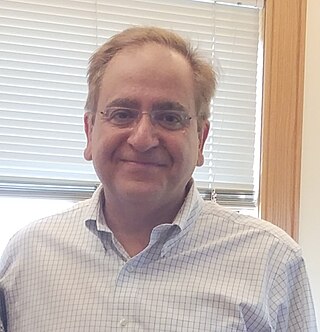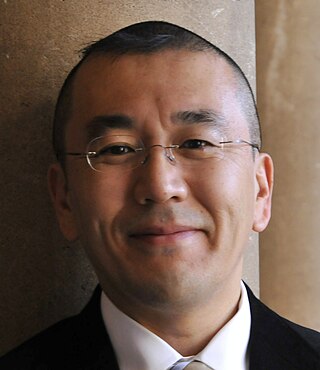Related Research Articles

Edward Witten is an American mathematical and theoretical physicist. He is a professor emeritus in the school of natural sciences at the Institute for Advanced Study in Princeton. Witten is a researcher in string theory, quantum gravity, supersymmetric quantum field theories, and other areas of mathematical physics. Witten's work has also significantly impacted pure mathematics. In 1990, he became the first physicist to be awarded a Fields Medal by the International Mathematical Union, for his mathematical insights in physics, such as his 1981 proof of the positive energy theorem in general relativity, and his interpretation of the Jones invariants of knots as Feynman integrals. He is considered the practical founder of M-theory.
In theoretical physics, S-duality is an equivalence of two physical theories, which may be either quantum field theories or string theories. S-duality is useful for doing calculations in theoretical physics because it relates a theory in which calculations are difficult to a theory in which they are easier.

Cumrun Vafa is an Iranian-American theoretical physicist and the Hollis Professor of Mathematicks and Natural Philosophy at Harvard University.

Nathan "Nati" Seiberg is an Israeli American theoretical physicist who works on quantum field theory and string theory. He is currently a professor at the Institute for Advanced Study in Princeton, New Jersey, United States.
Montonen–Olive duality or electric–magnetic duality is the oldest known example of strong–weak duality or S-duality according to current terminology. It generalizes the electro-magnetic symmetry of Maxwell's equations by stating that magnetic monopoles, which are usually viewed as emergent quasiparticles that are "composite", can in fact be viewed as "elementary" quantized particles with electrons playing the reverse role of "composite" topological solitons; the viewpoints are equivalent and the situation dependent on the duality. It was later proven to hold true when dealing with a N = 4 supersymmetric Yang–Mills theory. It is named after Finnish physicist Claus Montonen and British physicist David Olive after they proposed the idea in their academic paper Magnetic monopoles as gauge particles? where they state:
There should be two "dual equivalent" field formulations of the same theory in which electric (Noether) and magnetic (topological) quantum numbers exchange roles.
In theoretical physics, topological string theory is a version of string theory. Topological string theory appeared in papers by theoretical physicists, such as Edward Witten and Cumrun Vafa, by analogy with Witten's earlier idea of topological quantum field theory.
In string theory, K-theory classification refers to a conjectured application of K-theory to superstrings, to classify the allowed Ramond–Ramond field strengths as well as the charges of stable D-branes.
Konrad Osterwalder is a Swiss mathematician and physicist, former Undersecretary-General of the United Nations, former Rector of the United Nations University (UNU), and Rector Emeritus of the Swiss Federal Institute of Technology Zurich. He is known for the Osterwalder–Schrader theorem.

David Ian Olive ; 16 April 1937 – 7 November 2012) was a British theoretical physicist. Olive made fundamental contributions to string theory and duality theory, he is particularly known for his work on the GSO projection and Montonen–Olive duality.

Hirosi Ooguri is a theoretical physicist working on quantum field theory, quantum gravity, superstring theory, and their interfaces with mathematics. He is Fred Kavli Professor of Theoretical Physics and Mathematics and the Founding Director of the Walter Burke Institute for Theoretical Physics at California Institute of Technology. He is also the director of the Kavli Institute for the Physics and Mathematics at the University of Tokyo and is the chair of the board of trustees of the Aspen Center for Physics in Colorado.
Warren Siegel is a theoretical physicist specializing in supersymmetric quantum field theory and string theory. He was a professor at the C. N. Yang Institute for Theoretical Physics at Stony Brook University. He retired in Fall of 2022.
Nikita Alexandrovich Nekrasov is a Russian mathematical and theoretical physicist at the Simons Center for Geometry and Physics and C.N.Yang Institute for Theoretical Physics at Stony Brook University in New York, and a Professor of the Russian Academy of Sciences.
Gordon Walter Semenoff, ,, is a theoretical physicist and professor of physics at the University of British Columbia, Canada. He is known for his research on quantum mechanics, quantum field theory, statistical mechanics and string theory and is particularly famous for his co-invention, together with Antti Niemi, of the parity anomaly in odd-dimensional gauge field theories and for his pioneering work on graphene. He is also well known for development of thermal field theory, the application of index theorems and their generalizations in quantum field theory and string theory, notably with respect to the duality between string theories and gauge field theories.

Werner Nahm is a German theoretical physicist. He has made contributions to mathematical physics and fundamental theoretical physics.
Paolo Di Vecchia is an Italian theoretical physicist who works in the field of elementary particle physics, quantum field theory and string theory.

Samson Lulievich Shatashvili is a theoretical and mathematical physicist who has been working at Trinity College Dublin, Ireland, since 2002. He holds the Trinity College Dublin Chair of Natural Philosophy and is the director of the Hamilton Mathematics Institute. He is also affiliated with the Institut des Hautes Études Scientifiques (IHÉS), where he held the Louis Michel Chair from 2003 to 2013 and the Israel Gelfand Chair from 2014 to 2019. Prior to moving to Trinity College, he was a professor of physics at Yale University from 1994.

Atish Dabholkar is an Indian theoretical physicist. He is currently the Director of the Abdus Salam International Centre for Theoretical Physics (ICTP) with the rank of Assistant Director-General, UNESCO. Prior to that, he was head of ICTP's High Energy, Cosmology and Astroparticle Physics section, and also Directeur de Recherche at the Centre National de la Recherche Scientifique (CNRS) at Sorbonne University in the "Laboratoire de Physique Théorique et Hautes Énergies" (LPTHE).
Supersymmetric localization is a method to exactly compute correlation functions of supersymmetric operators in certain supersymmetric quantum field theories such as the partition function, supersymmetric Wilson loops, etc. The method can be seen as an extension of the Berline–Vergne– Atiyah– Bott formula for equivariant integration to path integrals of certain supersymmetric quantum field theories. Although the method cannot be applied to general local operators, it does provide the full nonperturbative answer for the restricted class of supersymmetric operators. It is a powerful tool which is currently extensively used in the study of supersymmetric quantum field theory. The method, built on the previous works by E.Witten, in its modern form involves subjecting the theory to a nontrivial supergravity background, such that the fermionic symmetry preserved by the latter can be used to perform the localization computation, as in.

Zvi Bern is an American theoretical particle physicist. He is a professor at University of California, Los Angeles (UCLA).
Zohar Komargodski is an Israeli theoretical physicist who works on quantum field theory, including conformal field theories, gauge theories and supersymmetry.
References
- ↑ "Nikolai Kapustin" . Retrieved January 27, 2021.
- ↑ "Anton Kapustin | Professor". researchgate.net.